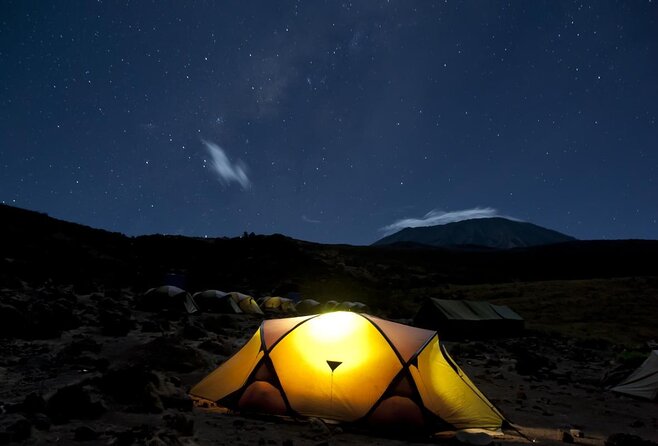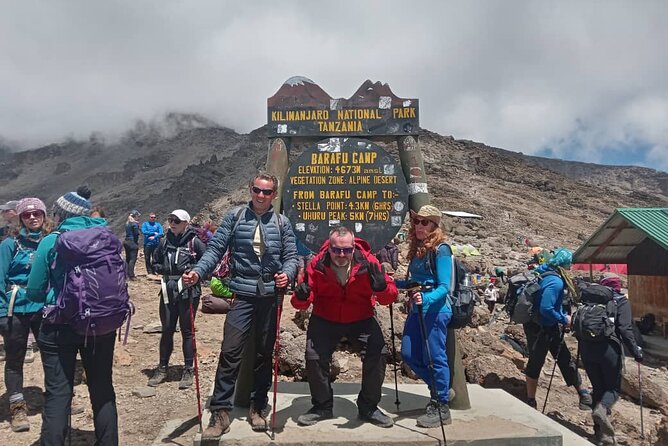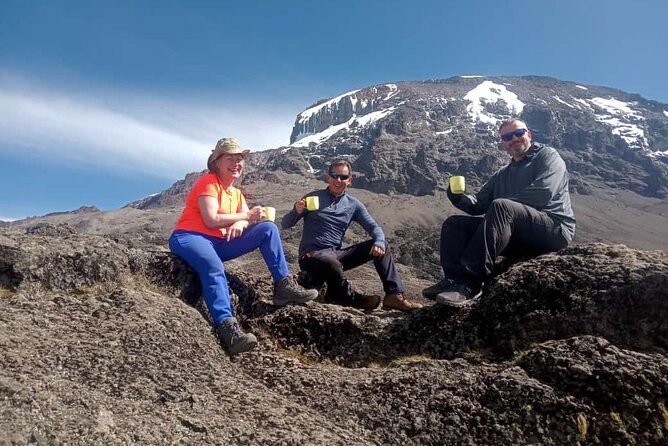Located in Tanzania, the Machame Route is one of the most popular paths to ascend Kilimanjaro, accounting for approximately 50% of all climbers. As adventurers set foot on this renowned trail, they are greeted by a diverse landscape, ranging from lush rainforests to alpine deserts, promising an unforgettable journey to the summit of Africa’s tallest peak.
With each day presenting new challenges and breathtaking vistas, the Machame Route beckons both novice and seasoned climbers to test their limits and embrace the thrill of conquering Kilimanjaro’s majestic heights.
Good To Know

- Altitude acclimatization is crucial for a successful climb on the Machame Route.
- The route offers diverse landscapes, from lush rainforests to alpine deserts.
- Weather conditions vary significantly, requiring proper gear and preparation.
- Mental and emotional readiness are essential for the challenges of a 7-day Kilimanjaro climb.
Route Overview
Embark on an exhilarating journey through diverse landscapes and varying terrains as the Machame Route offers climbers a challenging yet rewarding path to the summit of Kilimanjaro.
Altitude acclimatization is crucial on this route due to the rapid ascent, allowing climbers to adjust gradually and reduce the risk of altitude sickness.
Weather conditions play a significant role in this adventure, with temperatures ranging from hot at the base to freezing at the summit. Rain can also be a factor, especially in the rainy seasons of April, May, and November.
Climbers should be prepared for these fluctuations and pack accordingly to ensure a safe and successful trek. The Machame Route promises an unforgettable experience for those willing to take on its challenges.
Find more activities and experiences we've covered in Moshi.
Day 1: Machame Gate to Machame Camp

As climbers pass through Machame Gate, the beginning of their journey to Machame Camp unfolds amidst the stunning landscapes of Kilimanjaro.
The trail on the first day involves a gradual ascent through the lush rainforest, providing climbers with opportunities to start their altitude acclimatization.
Along the way, hikers can enjoy scenic viewpoints offering glimpses of the surrounding vegetation and wildlife.
The trek to Machame Camp is invigorating, with the sounds of nature accompanying each step.
As adventurers navigate the winding paths and varying terrain, they begin to enjoy the unique experience of trekking towards the towering peak of Kilimanjaro.
The first day sets the stage for the challenges and triumphs that lie ahead on this remarkable journey.
Day 2: Machame Camp to Shira Camp

The journey from Machame Camp to Shira Camp on Day 2 of the Kilimanjaro climb presents climbers with a challenging yet breathtaking trek through diverse terrain and changing landscapes. As climbers ascend higher, acclimatization becomes crucial to combat altitude sickness.
Some acclimatization tips include staying hydrated, maintaining a steady pace, and listening to your body. Packing essentials like warm layers, sturdy boots, and sunscreen are vital for this leg of the journey. Hydration strategies, such as using a hydration pack for easy access to water, play a significant role in combating altitude effects.
With the right preparation and mindset, climbers can navigate the transition from Machame Camp to Shira Camp successfully, soaking in the beauty of Kilimanjaro along the way.
Day 3: Shira Camp to Barranco Camp
Starting the exhilarating trek from Shira Camp to Barranco Camp on Day 3, climbers enjoy a landscape that showcases Kilimanjaro’s awe-inspiring beauty and challenges their determination. As they ascend, the air thins, prompting the need for acclimatization tips to combat altitude sickness.
Along the way, climbers are treated to breathtaking scenic views, including the vast expanse of the Shira Plateau and the rugged Barranco Wall. The trail meanders through diverse terrain, from rocky outcrops to lush moorlands, providing a true test of endurance.
Careful pacing and hydration are key to a successful climb, ensuring that each adventurer can fully appreciate the natural wonders that unfold before them on this challenging but rewarding journey.
Day 4: Barranco Camp to Karanga Camp
Embarking from Barranco Camp on Day 4, climbers traverse diverse landscapes as they make their way towards the next destination, Karanga Camp, amidst the majestic surroundings of Kilimanjaro. The journey offers breathtaking scenic views, with the towering peak of Kilimanjaro in the backdrop inspiring every step.
As climbers ascend, it’s crucial to heed acclimatization tips provided by guides to adjust to the altitude effectively. Taking it slow, staying hydrated, and listening to one’s body are essential for a successful climb.
The transition from Barranco to Karanga Camp isn’t just a physical progression but also a mental and emotional one, as climbers soak in the beauty of their surroundings while preparing for the challenges ahead.
Day 5: Karanga Camp to Barafu Camp
Ascending from Karanga Camp towards Barafu Camp on Day 5 infuses climbers with a sense of anticipation and determination as they inch closer to the summit of Kilimanjaro. Along this challenging stretch, climbers focus on acclimatization strategies to combat high altitude challenges.
Here are some key elements of this leg of the journey:
- Stunning Views: The landscape transforms, offering breathtaking panoramas of the surrounding peaks.
- Technical Terrain: Climbers navigate rocky paths and steep inclines requiring focus and agility.
- Weather Shifts: Rapid weather changes demand quick adjustments in clothing and gear.
- Group Support: Team spirit and encouragement become crucial in pushing through the demanding ascent.
Day 5 is a pivotal point in the climb, testing both physical endurance and mental resilience as adventurers push towards their ultimate goal.
Day 6: Barafu Camp to Summit and Mweka Camp
As climbers depart from Barafu Camp on Day 6, they set their sights on conquering the summit and descending to Mweka Camp on their exhilarating Kilimanjaro adventure.
The summit experience presents both a mental and physical challenge due to the altitude, testing their determination and resilience. Altitude challenges like shortness of breath and fatigue accompany the awe-inspiring views and sense of accomplishment as they reach Uhuru Peak, the highest point in Africa.
After absorbing the triumph of their summit achievement, climbers begin their descent towards Mweka Camp, where celebratory achievements await.
The descent to Mweka Camp is a mix of relief and fatigue, marked by reflections on the journey and the camaraderie built among the climbers.
Day 7: Mweka Camp to Mweka Gate
Descending from the heights of triumph at Uhuru Peak, climbers on Day 7 make their way from Mweka Camp towards the final leg of their Kilimanjaro journey, heading to Mweka Gate. As they descend, reflections on the challenging yet rewarding expedition fill their minds. The lush rainforest scenery provides a stark contrast to the icy summit, offering a serene backdrop for contemplation.
The scent of the forest permeates the air, a welcome change from the thin mountain atmosphere.
Birdsong fills the canopy, a cheerful accompaniment to the descent.
The trail winds down, revealing glimpses of the surrounding landscape through the trees.
Frequently Asked Questions
Is Altitude Sickness a Common Issue on This Trek, and How Is It Managed?
Altitude sickness can be a concern while trekking, but on this adventure, climbers benefit from altitude acclimatization, proper hydration, medication if needed, and expert mountain guides who monitor and manage symptoms, ensuring a safe and enjoyable journey.
Are There Any Cultural or Environmental Considerations to Be Aware of While Trekking on the Machame Route?
When trekking the Machame Route, hikers should respect local customs and nature. Cultural etiquette involves greeting locals politely and dressing modestly. Environmental conservation is crucial; leave no trace, avoid littering, and adhere to park regulations to preserve Kilimanjaro’s beauty.
Are There Any Specific Training Recommendations or Tips for Preparing for This Trek?
For those gearing up for the adventure, training tips and a fitness regimen are crucial. Building endurance, strength, and mental resilience will enhance the climbing experience on the Machame Route, paving the way for summit success.
What Happens in Case of Extreme Weather Conditions During the Climb?
In case of extreme weather during the climb, climbers must adhere to safety measures. Climbing strategies may change, gear requirements could increase, and clear communication plans become crucial. The crew will guide and support climbers through any challenging conditions.
Are There Any Emergency Evacuation Procedures in Place in Case of Accidents or Health Emergencies During the Trek?
In case of accidents or health emergencies during the trek, emergency procedures are in place. Trained guides will assess the situation, provide first aid, and coordinate evacuation if necessary. Safety of climbers is the top priority.
The Sum Up
Embark on the ultimate adventure of a lifetime with the 7-Days Kilimanjaro Climbing via Machame Route expedition. Conquer the majestic Kilimanjaro with professional guides, comfortable accommodations, and all meals provided.
From the Machame Gate to the Summit and back, this journey offers breathtaking views and unforgettable memories. Don’t miss out on this thrilling experience for outdoor enthusiasts seeking a challenge and the chance to stand atop Africa’s highest peak.
Book your adventure today and make your Kilimanjaro dream a reality!
More Tour Reviews in Moshi
Looking for something different? Other Moshi activities we've written about
- 19 Best Spa And Hot Springs Experiences In Moshi
- 25 Best Tours In Moshi
- 3 Best Workshops And Classes In Moshi
- 20 Best 3 Day Tours In Moshi
- 3 Best Full-Day Tours In Moshi
- 20 Best 4 Day Tours In Moshi
- 10 Best Private Driver Services In Moshi
- 25 Best Safari Tours In Moshi
- 10 Best Airport Transfers In Moshi
- 20 Best 2 Day Tours In Moshi
- 8 Best Guided Tours In Moshi
- 4 Best Historical Tours In Moshi
